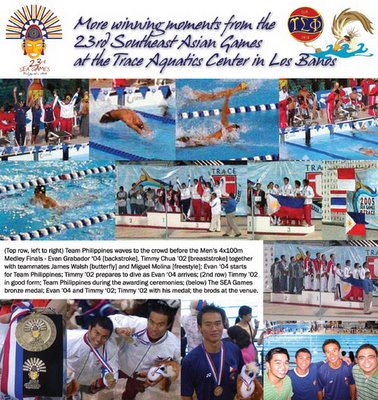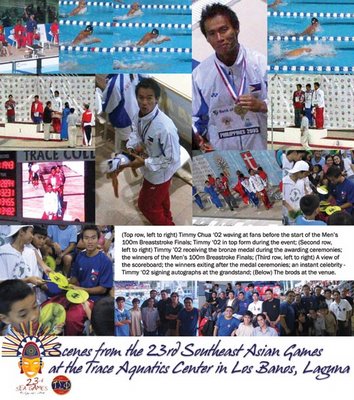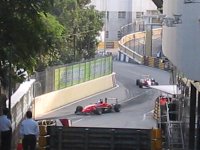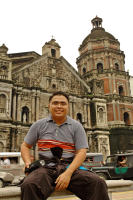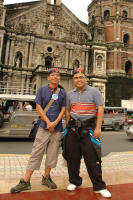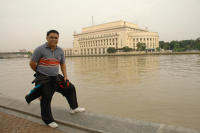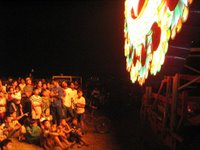 Just a few hours before Christmas! Masayang Pasku kekayu ngan! I just came from a tiring drive. I was on my way back to Manila from Pampanga when I was reminded by a friend of mine that she had ordered ensaimada. Damn! It slipped my mind! So to make the long story short, I drove to Manila to pick up the orders; went back to Pampanga to make the delivery; and now I'm back in Manila in time for our noche buena. Ever since my lolo died in 1993, our clan no longer does its annual tradition of sleeping over in Pampanga for Christmas eve since an uncle and aunt are scared to sleep in the old house, fearful of lolo's ghost. Thus, I traversed the NLEX three times in two hours! And tomorrow, I will use the NLEX two more times when I go back to Pampanga to visit relatives and back home again. I wish the toll was cheaper!
Just a few hours before Christmas! Masayang Pasku kekayu ngan! I just came from a tiring drive. I was on my way back to Manila from Pampanga when I was reminded by a friend of mine that she had ordered ensaimada. Damn! It slipped my mind! So to make the long story short, I drove to Manila to pick up the orders; went back to Pampanga to make the delivery; and now I'm back in Manila in time for our noche buena. Ever since my lolo died in 1993, our clan no longer does its annual tradition of sleeping over in Pampanga for Christmas eve since an uncle and aunt are scared to sleep in the old house, fearful of lolo's ghost. Thus, I traversed the NLEX three times in two hours! And tomorrow, I will use the NLEX two more times when I go back to Pampanga to visit relatives and back home again. I wish the toll was cheaper!I had arrived in San Fernando the day before to watch the exhibition of giant lanterns (I missed the Giant Lantern Festival this year since I had an affair to attend in Tagaytay that night). So I had to make do with the post-festival exhibitions. And like in any big event, expect hawkers (vendors to us Filipinos) to gate crash. So before the program, I had a sampling of Pampanga street food... fried breaded chicken skin! Hehe! More LDL for me (if you still cannot distiguish whether HDL or LDL is the good or bad cholesterol, just remember LDL = lechon de leche... hehe!).
The Giant Lantern Festival is quite close to my heart. Aside from the fact that it is the pride of the City of San Fernando, Pampanga and that in 2003, at the age of 24, I became the youngest person ever to serve as chairman of the Giant Lantern Festival Executive Committee; the giant lanterns of San Fernando make me proud to be a Filipino. Watching these technological works of art never cease to amaze me as I marvel at the craftsmanship and ingenuity of the Fernandino lantern makers.
As tourism officer of the City of San Fernando, I wrote many of the articles and promotional materials for the festival which are still in use today. Allow me thus to quote an old article which has become staple in promoting the festival:
Henares, Ivan Anthony S. (2001). How to make a giant lantern: The story behind the giant lanterns of San Fernando. School Project. University of the Philippines (Extension Program in Pampanga).
Most only see the finished product. The dynamic interplay of lights and color that precisely moves with the rhythm of a brass band, the magnitude of size and their intricate designs, and so much more which spectators only get to appreciate as the giant lanterns of San Fernando are pitted against each other on festival night. No one can dispute the fact that the Giant Lantern Festival of San Fernando is the event that the province of Pampanga is most known for. And it is sad that we rarely acknowledge the tremendous preparation and investment the makers put in each of these giant lanterns. It is because of these giant lanterns and the San Fernando lantern-making industry that the City of San Fernando has been dubbed the Christmas Capital of the Philippines.
San Fernando and the Christmas lantern
It is one of the trades that are undisputedly Kapampangan. Lantern making first began in the town of San Fernando during the early part of this century. What distinguish the San Fernando lantern from the ordinary parol are the intricate designs and the illusion of dancing lights, which highlight the vibrant colors of the lantern.
The Christmas lantern can never be distanced from the town which created it, the City of San Fernando. It is what San Fernando is known for. And it is what has made the city famous all over the country and even around the world. Such a creation however, did not come without the untiring efforts of San Fernando’s citizens, and more so, their creativity and innovation. And it is because of the Christmas lantern that San Fernando has earned for itself the title of Christmas Capital of the Philippines. And to truly appreciate the colorful and intricate display of lights, one must understand its deep history and the strong traditions involved in the creation of the San Fernando Giant Lantern.
The Giant Lantern Festival
The San Fernando lantern industry evolved from the Giant Lantern Festival of San Fernando. The festival, which is held every December, finds its roots in Bacolor where a much simpler activity was held. Following the transfer of the provincial capital from Bacolor to San Fernando in August of 1904, this parul event followed as well. "Ligligan Parul" was said to have started in San Fernando in the year 1904. But some say that the "Ligligan Parul" did not happen immediately after the transfer and in fact began in 1908.
This predecessor of the modern day Giant Lantern Festival was actually a religious activity which we know today as “lubenas.” The lanterns measured just two feet in diameter, a far cry from the fifteen feet that we see today. These were created in each barrio from bamboo and other locally available materials. During the nine-day novena before Christmas, which coincided with the simbang gabi from December 16 to 24, these paruls were brought around each barrio in procession to their visita. Before the midnight Mass on Christmas Eve, the lanterns were brought to the town church together with the barrio patrons.
This tradition gradually evolved as the lanterns became bigger and the designs more intricate. Later, one big lantern was made for each barrio, which was created through a cooperative effort. Each resident contributed to its construction, from the concept and design, to the materials and labor. In the end, these lanterns became a symbol of unity for the barrios.
One version tells us that it was in the year 1931 that electricity was introduced to the San Fernando lantern, thus sparking the birth of the first Giant Lantern Festival. The added illusion of dancing lights highlighted the bright colors and intricate designs of these Giant Lanterns. At this time, the lights were controlled by individual switches that were turned on and off following the beat of the music. The barangays of Del Pilar, Sta. Lucia and San Jose were among the first barangays to participate in the festival.
According to another version claimed by old folks, the Giant Lantern Festival started during the time of President Manuel L. Quezon. At that time, President Quezon was trying to make Pampanga a model province. In fact, Quezon made Arayat his resting place and converted the legendary Mount Arayat into a tourist resort. As a show of gratitude to Quezon, the people of San Fernando held a Christmas lantern contest to honor the first family. Quezon himself donated the prize for this lantern contest, which was personally awarded to the winner by First Lady Aurora Aragon Quezon.
Fernandino creativity at work
In years that followed, more innovations were introduced to the giant lanterns. Colored plastic replaced the traditional papel de hapon. Large steel barrels called rotors also substituted the hand-controlled switches to manipulate the lights. Strips of masking tape on these rotors determine the sequence of the switching on and off of the lights.
The technology of the rotor is quite simple. Hairpins, attached to the end of the wires leading to each individual bulb, connect the lights to the rotor, which in turn, is connected to the source of electricity. Strips of masking tape are placed on the metal rotor to serve as light switches. As the rotor is turned, the hairpins pass through the strips of masking tape. When a certain hairpin hits a strip of masking tape, the current to a specific set of bulbs is temporarily cut thus switching off that particular set of bulbs. When that particular hairpin regains contact with the steel barrel, the bulbs are again lit. Thus, the placement of the masking tape on the rotors determines the interplay of lights on the lanterns and can spell success or disaster for each entry.
Thinking about it, one needs a lot of creativity and technical know-how in designing a giant lantern. It is not as easy as getting a pen and paper and drawing a symmetrical design. As the giant lantern maker visualizes his design, he also has to take into consideration the interplay of lights and colors. And just to illustrate the magnitude of difficulty, the designer should be able to picture when each of the 3,500 light bulbs should go on and off. And just to stress, no computers are involved in the interplay of lights. Everything is done manually, yet the result produced by the lantern makers of San Fernando can even rival light effects done by computers.
The design, however, is just a part of the actual labor involved in the creation of a giant lantern. Once this has been finalized, the lantern makers weld together a steel frame, which follows the design itself. This is the first step in the actual construction of the giant lantern.The frame is then lined with cardboard and foil. This is followed by another monumental task, placing the over 3,000 light bulbs in their proper places and wiring them up together. Even an expert electrical engineer would go crazy while working on this intricate network composed of hundreds of yards of electrical wires.
The wires are then connected to the rotors. And let me stress rotors with an "s" since barangays have to change the interplay of lights with each tune. In fact, some barangays even use as much as eight to ten of these steel barrels for variety in movement. Finally, there is of course the plastic covering, which is cut and shaped precisely to fit each section.
The Giant Lantern Festival is an inter-barangay contest. In past festivals, it really was a barangay effort and the best lantern makers of the barangay were called on to create the entry to the competition. During that time, each participating barangay had resident lantern makers. However, as the years passed, many of these lantern makers were unable to pass on the trade. Today, only Del Pilar, Sta. Lucia, Dolores and San Jose can boast of resident lantern makers. So to keep the show on the road, other barangays have to rely on lantern makers from other localities.
Ernesto D. Quiwa of Barangay Sta. Lucia is one of these veteran giant lantern makers. Although from Sta. Lucia, he has actually created lantern entries for other barangays. During last year's festival, Mang Erning created the entry for Barangay San Nicolas, which was adjudged the over-all champion of the year 2000 competition. His creations have in fact won the over-all honors in previous years including 1974, 1982, and a three-peat from 1993 to 1995. This year, he is again making the one for San Nicolas. In fact, aside from Sta. Lucia's own entry and the entry of San Nicolas, it is said that two other lantern entries are also being made in the same barangay.
With all that discussion on the creation of a giant lantern, one realizes that just by looking at the many materials and the amount of effort put into each lantern, that would of course not be possible without any incurred costs. And the expenses are definitely not loose change and are said to be close to P100,000 for each of these giant lanterns. So where do the participating barangays get their funds?
Being the most popular festival in Pampanga and world-renowned at that, no one can blame the City Government of San Fernando for putting so much value on the Giant Lantern Festival. It in fact provides the funding for most of the expenses of each lantern as it has done so in previous competitions. San Fernando is simply living up to its well-earned name as the unmatched "Christmas Capital of the Philippines."
It is a work of love and full of passion. The San Fernando giant lantern is a product of Kapampangan innovation, creativity and tireless effort. So the next time you witness their spectacular display of lights and color, do appreciate the hard work put into each of these works of art that can be considered truly Kapampangan.





